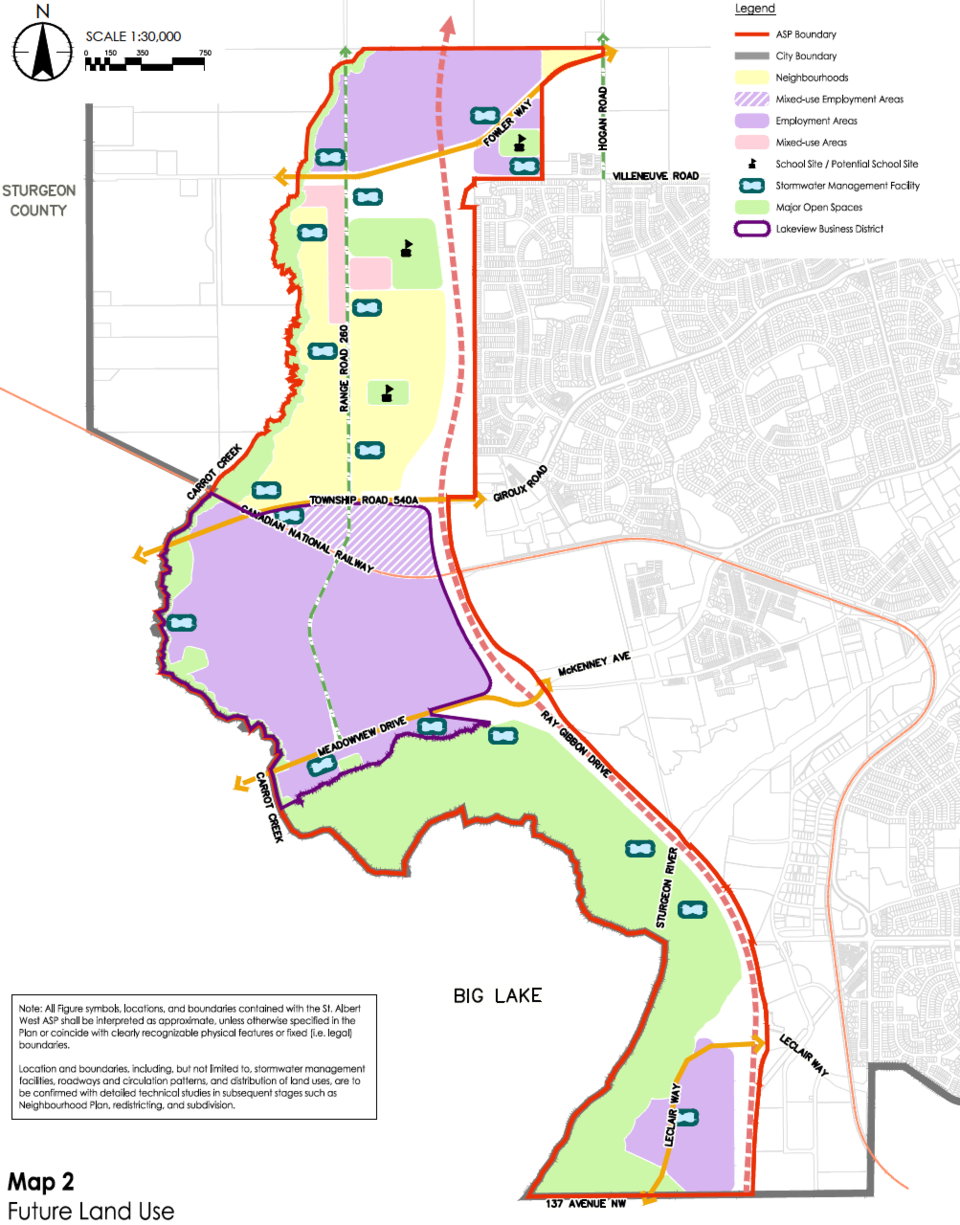A draft of St. Albert's West Area Structure Plan (ASP), which has been in development for nearly two years, is almost complete, council heard this week.
The city's West ASP, which is a legally required planning document, will determine how much and what kind of development will take place around Big Lake Provincial Park and to the west of Ray Gibbon Drive.
The more than 1,000 hectares of land covered under the ASP stretches from Carrot Creek to the west, Ray Gibbon Drive to the east, LeClair Way to the south, and slightly past Villeneuve Drive to the north. The ASP contains the land that will eventually become the long-talked about Lakeview Business District; a potential recreational centre; and the city's Badger Lands, which were once planned to be home to the city's solar farm.
Speaking to council's committee of the whole on Tuesday, city planner Tracy Tsui said the underlying vision for the land is that it's a “key growth area” in St. Albert.
“It will significantly impact economic and employment diversification,” Tsui said. “It is an area where people can work, live, and recreate; it is a place for varied housing options and a walkable and well-connected community; and there will be importance placed on the ecological integrity of Big Lake, Carrot Creek, Sturgeon River and other natural features.”
The most up-to-date land-use map for the area covered under the ASP, which was presented to council for the first time on Dec. 12, shows much of the overall area will be devoted to employment areas, residential areas (Cherot), green space, and mixed-use employment areas.
Tsui told council the Cherot neighbourhood represents 12.1 per cent of the developable area covered under the ASP, while the employment areas including Lakeview Business District represent “about 47” per cent.
“The objective of employment areas is to accommodate a diversity of light industrial, institutional, professional office buildings, and other uses that generate employment opportunities and economic activity,” Tsui said. “It's also anticipated that the employment areas accommodate the city's focus sectors, including agribusiness, advanced manufacturing, construction, life sciences, transportation and logistics.”
The future Lakeview Business District has been touted by members of council, as well as Mayor Cathy Heron, as the city's best opportunity to shift more of the annual property tax requirements from residential properties to commercial properties.
The business district, once developed, is estimated to create the space for 5,000 jobs. Prior to its development, however, the city will need to service the area, and although an up-to-date estimate for servicing costs hasn't been produced, Heron previously told the Gazette she thinks it could be as much as $80 million.
Council also heard on Tuesday that servicing the area — building electric, sewage, and water infrastructure — could take more than three years.
The new land-use map also shows three school sites, including the future school anticipated to be semi-incorporated into the city's future recreation centre, as well as a small school site on the Badger Lands, which is a new addition to the ASP's development since the last update council received in May.
The committee of the whole moved in-camera on Tuesday to discuss some potential land uses for the city-owned Badger Lands, citing section 25 of the Freedom of Information and Privacy Act, which refers to the need for private discussion to protect economic interests.
Prior to moving in camera, the city's director of planning and engineering, Adryan Slaght, said only after administration completes a Neighbourhood Plan for the Badger Lands will the city's plan for the land be made public.
A neighbourhood plan is a secondary plan that will exist within the West ASP, and Slaght said the Badger Lands neighbourhood plan is expected to be complete near the end of 2024.
A final draft of the West ASP is expected to be finished and and ready for publication in May or June of next year, Tsui wrote in a report to council.
Tsui's report explains that the delay is because a few technical studies still need to be reviewed, after which administration might make some final changes before publishing a draft.
Tony Druett, the vice president of the Big Lake Environment Support Society (BLESS), also spoke to the committee on Tuesday, and asked council to consider having more public engagement on the West ASP prior to the finalized draft going to council for approval.
In response, Tsui told council more public engagement would only further delay the project, and residents will have the opportunity to provide council with feedback on the draft ASP during the public hearing that must occur prior to council completing first reading.
Council is scheduled to hold a public hearing and complete the first of three readings of the ASP next June.




